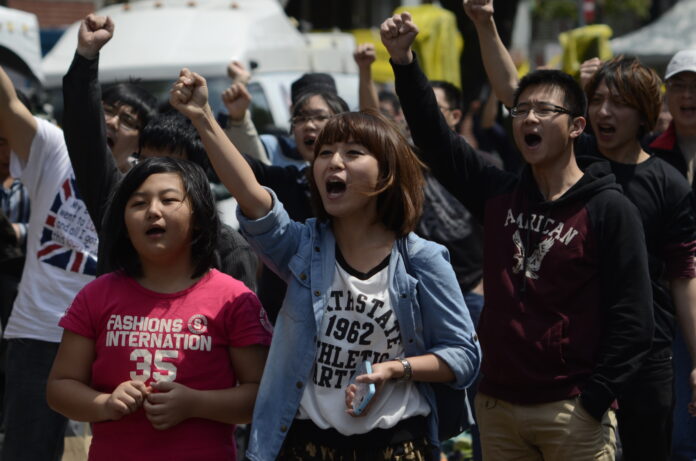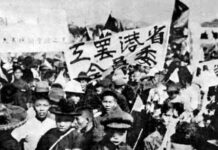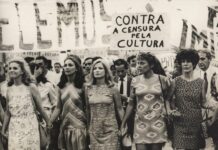Important lessons from the mass struggle against the Ma government of March-April 2014
Vincent Kolo
Ten years ago, a mass movement erupted in Taiwan which shook the whole capitalist establishment and resulted in a permanent irreversible political shift. As shown by subsequent events, the big losers from the 2014 struggle were the Chinese regime and the Kuomintang (KMT) in Taiwan.
Socialists examine all major movements and mass struggles to learn their internal dynamics, which class forces were involved, what did these struggles achieve or not achieve, and what does this mean for future struggle perspectives? In the same vein we also discuss the lessons of the 1989 democracy struggle in China, the mass anti-authoritarian movements of 2003, 2014 and 2019 in Hong Kong, and also of course important struggles on the world stage such as in Iran and Myanmar quite recently.
A model for Marxists
The events in Taiwan in 2014 have an added importance for Socialist magazine and our organization ISA because we were there as a small but extremely active group fighting for a distinctive working class and socialist way forward for the struggle. For a serious socialist organization words and deeds are not separate but must combine: theory must be turned into action. When the protests began, we had only a tiny and rather loose collection of supporters in Taiwan. We immediately sent a full-time organizer from Hong Kong for the duration of the battle to pull together and organize our supporters into a serious campaigning group.
The articles we reprint here are some of the many we published as leaflets and reports during the mass struggle. It’s a fact that issue 25 of Socialist magazine, which was published during the Sunflower movement, sold over 2,000 copies in Taipei and Hong Kong, where we also organized solidarity activities. This gives a glimpse of what was a very successful intervention for a socialist organization. It is through this hard work, decisive intervention, and clear political analysis, that ISA was for the first time able to establish a consolidated and politically cohesive branch in Taiwan.
The Sunflower movement was triggered on 18 March 2014, also known as the “318 incident”, when a few hundred students and NGO activists entered and occupied the main chamber of the Legislative Yuan. Their aim was to block (literally) the government of president Ma Ying-jeou from bulldozing its flagship Cross-Strait Service Trade Agreement (CSSTA) through the legislature.
This was a classically neo-liberal trade deal, with the capitalists standing to gain significantly (hence their pressure on Ma’s government to deal firmly with the protesters) at the expense of workers. The CSSTA also raised widespread fears that under Ma and the KMT the island was succumbing step-by-step to Beijing’s greater control.
The student occupation would last for 24 days, ending on 10 April. This triggered a mass movement that went far beyond the occupiers’ expectations. At its height, 500,000 marched in Taiwan’s biggest ever demonstration. We have seen such phenomena before. The students in Beijing in 1989 also never anticipated that their initial protests would trigger a potentially revolutionary mass movement that came close to bringing down the CCP dictatorship.

Mass struggle changes the equation
We can say in hindsight that these 24 days changed Taiwan. The repercussions also extended to China and the wider region. Up until the 2014 mass protests, the main policy direction of the Chinese and Taiwanese capitalists was towards ever closer economic alignment. Economists spoke of a “China-centric growth strategy”.
By 2014, Taiwanese capitalists had invested US$140 billion in China, although this process was already slowing. Last year, Taiwanese investments in China fell to the lowest level since 2001. The imperialist Cold War that today pits US and Chinese imperialism in a fierce global contest over economic and even military dominance, with Taiwan as one of its most important battlegrounds, was still only beginning to take shape at the time of the 2014 movement.
In the 2012 election, US imperialism’s clear preference was for Ma’s reelection. The fact that both Beijing and Washington supported the same side in this election underlines how much the world and the region has changed since then. Ma’s challenger, Tsai Ing-wen of the DPP, went to Washington three months before the election but failed to win favour with US officials. Not only did the Obama Administration approve an arms deal with Ma’s government only weeks before the election, effectively giving him Washington’s public endorsement, but an anonymous US spokesman leaked to the Financial Times that the US was concerned a Tsai victory would “raise tensions with China”. (US concerned about Taiwan candidate, Financial Times, 15 September 2011).
For the CCP regime, the main agency to advance the economic and – they hoped – political integration of China and Taiwan was the KMT under Ma. In his sixth year of rule by the time the Sunflower movement broke out, however, Ma was already deeply unpopular. As our articles show, the president’s support was a record low 9 percent and actually fell a further five percentage points during the mass protests.
Point of ‘no return’ for KMT
The KMT and its ‘pan blue’ bloc (leaning towards unification with China) was shattered as a result of this movement from which there has been no coming back. This fact, unforeseen by most of the forces involved in the 2014 movement, inflicted a permanent change on Taiwan’s political development, weakening the pro-CCP tendencies within the ruling class and strengthening their opposite pole. This is the explanation of the electoral rise of the ‘pan green’ (against unification) Democratic Progressive Party (DDP), which this year won the presidency for an unprecedented third consecutive term. This is not primarily based on a pro-DPP mood so much as hostility to the CCP dictatorship and the KMT, widely regarded as its local comprador.
Correspondingly, there has been a seismic shift in national consciousness. Especially when the political system is in crisis, this can find an expression in increased nationalism. The workers’ movement needs to be sensitive to these changes, to see what is progressive (pointing in the direction of struggle against capitalism) and what is reactionary (dividing and weakening the class struggle). Socialists fight for the right of self-determination for Taiwan, including independence. But we also explain that independence must begin by breaking with the parties of capitalism. The capitalist politicians, whether blue, green or white, only dance to the tune of Chinese or – increasingly – American imperialism. United mass struggle with the working class of other nations, especially China, to overthrow capitalism and imperialism, is the only way this struggle can succeed.
Numbers identifying as ‘Taiwanese’ rather than ‘Chinese’ have risen significantly in the wake of the Sunflower protests. A survey by National Chengchi University shows that in 2008, when Ma came to power, 48.4 percent of the population identified as Taiwanese and only 4 percent as Chinese, with 43.1 percent identifying as both. This changed to 60 percent, 3.5 percent and 32.5 percent in 2014. By 2020, the ratios had shifted to 67 percent, 2.4 percent and 27.5 percent.
This process was subsequently reinforced and cemented by the outbreak of the US-China Cold War. Here is an example of the dialectic at work: A political realignment produced by the interaction of contradictory forces among the masses overlapping with shifts in the policies of the ruling elites.
The events of 2014, resulting in the historic crisis of the Ma administration and the KMT, alienated wide layers of society – permanently – from the KMT, but especially the younger generation. The pan-blue presidential candidates’ share of the youth vote (under 30s) has shrunk successively from 55 percent in the 2008 election (the start of Ma’s era), to 35 percent in 2016 (the start of Tsai Ing-wen’s era), to 26.6 percent in 2020, to 20 percent in 2024 (when the TPP or ‘whites’ captured 25.5 percent of the under 30s’ vote).
The collapse in electoral support for the KMT among younger voters has continued even this year, which despite the victory of William Lai Ching-ti, revealed a parallel crisis and loss of support for the DPP. Lai’s election victory in the January presidential election was a shadow of Tsai’s victory in 2020 (5.6 million votes in total versus 8.2 million for Tsai). Rather than the KMT being able to profit from the powerful undercurrent of disillusionment with the DPP, it was the ultra-opportunist Ko Wen-je of the TPP that captured the disaffected youth vote, of course on a completely false basis of empty promises.
Ko even resurrected the corpse of the CSSTA in the recent election campaign in a cynical manoeuvre to win a section of pan-blue voters to his candidacy. When attacked by opponents for doing a u-turn – Ko had been a speaker during the Sunflower protests – he explained that his “opposition” to the CSSTA in 2014 had been on procedural grounds, over how it would be dealt with in the legislature, and was never against the deal on principle.
Capitalist electoral politics (there has never been a working class party in Taiwan) inevitably sees ups and downs due to the fundamental lack of any genuine alternatives. What separates the blue, green and – since 2019 – the white capitalist parties are only secondary differences. Even on the key issue of where to stand vis-à-vis China or the US in the Cold War confrontation, the blues and whites have essentially shifted to a pro-US position albeit of a slightly softer, more cautious variant than Tsai, Lai and the pan-greens.
The death of the CSSTA
As our articles show, the Sunflower movement did not end in a clear victory for the protests, which in our estimation would have been fully possible with a different leadership, one independent of the DDP leadership (which the 2014 student leaders were not), and with an orientation towards mobilizing strike action by students and – most importantly – workers.
Instead, the occupation ended with a fudged “compromise” that allowed the Ma government to save face while the occupation leaders could claim they were not ending their action empty-handed. Wang Jin-pyng, the KMT’s Speaker of the Legislative Yuan, brokered this deal, with the involvement of the DDP leadership (who feared the mass movement could escalate), adopting a new procedure to “examine all” cross-strait agreements before reviewing the CSSTA.
Ma never formally revoked the CSSTA, which means that under other circumstances i.e. a less fatally damaged KMT regime, the treaty might have been revived at a later stage once the crowds had dispersed and the ‘normality’ of capitalist politics resumed.
But despite the various schemes of the politicians and the insufficient resolve of the student leaders, the CSSTA was killed off by the mass movement. This is because the outcome of the Sunflower struggle changed the balance of social forces, permanently, leaving the KMT in deep crisis and limping towards eventual election defeat two years later. Once Tsai of the DPP had captured the presidency in 2016, Xi Jinping’s regime responded by freezing all negotiations between Beijing and Taipei, rendering the CSSTA a dead letter.

Limits of NGO-style politics
The plan for occupation was bold and no doubt courageous. But the student leaders soon found themselves at the epicentre of a struggle the scale and complexity of which they had never envisaged. As we wrote in Socialist magazine at that time, “students can play a good role in starting struggles, but they can’t finish them, especially if they remain as a student-only movement, which was the plan of the occupation leaders.” The decisive force for social change especially in movements that challenge the power and interests of the capitalists is the working class. As our reports show, the first steps for workers to discuss strike action began in the latter phase of the Sunflower movement, which was called off before this process could gain momentum.
The occupiers were typical of the NGO-type groupings that proliferate in Taiwan, and elsewhere, that play an outsized role in various social movements and struggles due to the historic weakness of workers’ organizations and lack of a democratically-organized mass movement.
These small activist groups lack independence from the political establishment, which is of course tied to capitalism and in the final analysis will never challenge its interests. This makes all such groupings prone to waver and retreat when – as is inevitable – the state and capitalist establishment launches counter-revolutionary attacks to try to split, isolate and undermine such struggles. Several of the 2014 student leaders were subsequently absorbed into the political apparatus of the DPP or its satellite parties (“little greens”).
The main traits of such middle class protest groups is a rather narrow political focus on a single-issue, lack of roots in the working class and undemocratic methods of top-down decision-making which is often falsely packaged as leaderless, “horizontal organization”.
One of the main lessons for workers and young people in Taiwan is how to overcome the limitations of “NGO-style” politics and organization in future mass struggles, which are undoubtedly coming. These problems exist everywhere but are even more acute in societies like Taiwan and Hong Kong. There, the working class lacks strong organizations and, due to the historical role of dictatorships which are always a brake on consciousness, lacks a left tradition. In China, the situation is even more pronounced because trade unions – the most basic organization of working class struggle – are outlawed and viciously repressed.
The Sunflower movement left a permanent stamp on the political map of Taiwan and the wider region. But while it inflicted a historic defeat on the former one-party dictatorship, the KMT, it failed to provide a political alternative from outside the capitalist establishment. The void caused by the KMT’s decline was filled instead by other capitalist parties that stand for fundamentally similar anti-working class policies. That the “new” TPP wants to recycle the “old” KMT trade pact, the CSSTA, symbolises how little real difference there is between the capitalist parties.
With a different leadership and strategy, one that consciously strove to mobilise the working class and base the struggle on organised mass action, rather than just cheering on the students as spectators, the Sunflower movement could have led to the emergence of a genuinely new political force in Taiwan: new mass trade unions and a working class party to challenge all the capitalist parties.
The capitalist regimes in our region, from the autocratic CCP to the ‘democratic’ DPP are balancing upon a volcano of social discontent as they try to patch up a capitalist and imperialist world system that is broken. The role of Marxists, as outlined by a single modest but foundational intervention ten years ago, is to organize and prepare for the eruption.
A selection of articles from CWI (as ISA was called) during the Sunflower movement:
Ma government rocked by mass protests and occupation of parliament
Half a million on the streets against Ma




